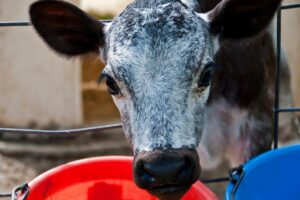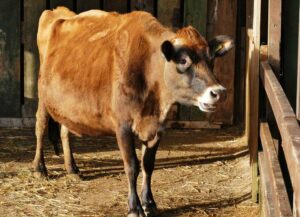Nuria García-Fernández
Monitoring and optimizing udder health of dairy cows is vital for increasing dairy milk production, sustainability, and economic efficiency. A recent study from Ghent University’s Faculty of Veterinary Medicine analyzed intramammary infections during the dry period using somatic cell count (SCC) data. Milk SCC is often used to determine whether a lactating cow has an intramammary infection. Generally, a cell count above 200,000 cells per mL indicates presence of infection.
The researchers Lipkens et al. (2019) determined rates of mammary infection at dry-off, evaluated whether those infection rates changed across the dry period, and the effects of the infections in the subsequent lactation. The study monitored 739 cows from 33 commercial Holsteins herds located in Flanders (Belgium). Cows had one test-day record before drying off (maximum of 42 days before) and at least 2 test-day records after calving, the first one performed between 12 and 40 days after calving. At drying off, all producers applied a blanket dry-cow antimicrobial therapy and 85% of them additionally applied internal teat sealers.
The results of this study were published in Journal of Dairy Science. The investigators found that:
- 57.4% of the cows remained healthy throughout the dry period (test-day SCC <200,000 cells/mL before and after the dry period).
- 8.3% acquired a new infection during the dry period (test-day SCC <200,000 cells/mL before and ≥200,000 cells/mL after the dry period).
- 23% cured from an existing infection during the dry period (test-day SCC ≥200,000 cells/mL before and <200,000 cells/mL after the dry period).
- 11.4% remained chronically infected (test-day SCC ≥200,000 cells/mL before and after the dry period).
Therefore, combining these data, the researchers concluded that there was a 12.6 percent risk of getting a new mammary infection during the dry period while the chances of getting cured was 66.9 percent. The new infection risk was calculated by dividing the number of cows with a new infection by the total number of healthy cows at drying off. Similarly, the cured infection risk was calculated by dividing the number of cows with cured infections by the total number of infected cows at drying off. These findings suggest that applying blanket dry-cow therapy at dry-off is not enough to guarantee adequate udder health at calving.
Mammary infection status during the dry period affected the evolution of test-day SCC, clinical mastitis risk, and culling hazard in the subsequent lactation:
- Test-day SCC after calving was higher in newly infected, cured, and chronically infected cows than in healthy cows.
- While 7.6% of healthy cows had clinical mastitis during the study, 13.5% of the newly infected, 15.4% of the cured, and 22.7% of the chronically infected cows had mastitis cases.
- Similarly, culling rate increased significantly from 3.5% in healthy cows to 4.9%, 6.5%, and 11.9% in newly infected, cured, and chronically infected cows, respectively. Therefore, chronic cows were 3.68 times more likely to be culled than healthy cows.
- Surprisingly, cow milk production was not associated with mammary infections during the dry period.
Interestingly, despite of having low SCC in their first day-test, cows that cured from a mammary infection during the dry period had higher SCC and were more likely to develop clinical mastitis and to be culled than healthy cows. It may be that these cows did not cure bacteriologically during the dry period or that they were more susceptible to new mammary infection due to anatomical damage to their teat canal.
In conclusion, maintaining healthy udders is always important, but it is especially important before drying off and during the dry period as it impacts cow performance in the following lactation. A successful dry-cow program should protect against new infections and cure existing infections. Cows starting the dry period with a mammary infection have higher risk of future infections and are also more likely of leaving the herd during the following lactation.
Reference
Lipkens, Z., S. Piepers, J. Verbeke, and S. De Vliegher. 2019. Infection dynamics across the dry period using Dairy Herd Improvement somatic cell count data and its effect on cow performance in the subsequent lactation. J. Dairy Sci. 102:640–651.











